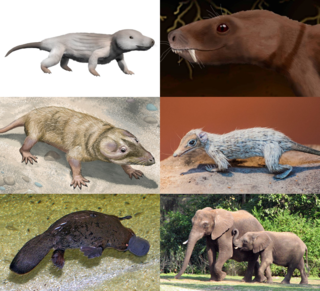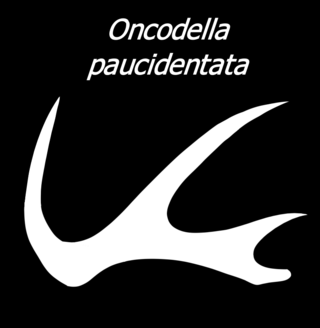Related Research Articles

Conodonts are an extinct group of agnathan (jawless) vertebrates resembling eels, classified in the class Conodonta. For many years, they were known only from their tooth-like oral elements, which are usually found in isolation and are now called conodont elements. Knowledge about soft tissues remains limited. They existed in the world's oceans for over 300 million years, from the Cambrian to the beginning of the Jurassic. Conodont elements are widely used as index fossils, fossils used to define and identify geological periods. The animals are also called Conodontophora to avoid ambiguity.

The cynodonts are a clade of eutheriodont therapsids that first appeared in the Late Permian, and extensively diversified after the Permian–Triassic extinction event. Cynodonts occupied a variety of ecologies, including as carnivores and herbivores. Mammals are cynodonts, as are their extinct ancestors and close relatives, having evolved from advanced probainognathian cynodonts during the Late Triassic. All other cynodont lines went extinct, with the last known non-mammalian cynodont group, the Tritylodontidae, having its youngest records in the Early Cretaceous.
The Rhaetian is the latest age of the Triassic Period or the uppermost stage of the Triassic System. It was preceded by the Norian and succeeded by the Hettangian. The base of the Rhaetian lacks a formal GSSP, though candidate sections include Steinbergkogel in Austria and Pignola-Abriola in Italy. The end of the Rhaetian is more well-defined. According to the current ICS system, the Rhaetian ended 201.4 ± 0.2 Ma.

The Carnian is the lowermost stage of the Upper Triassic Series. It lasted from 237 to 227 million years ago (Ma). The Carnian is preceded by the Ladinian and is followed by the Norian. Its boundaries are not characterized by major extinctions or biotic turnovers, but a climatic event occurred during the Carnian and seems to be associated with important extinctions or biotic radiations. Another extinction occurred at the Carnian-Norian boundary, ending the Carnian age.

In the geologic timescale, the Olenekian is an age in the Early Triassic epoch; in chronostratigraphy, it is a stage in the Lower Triassic series. It spans the time between 251.2 Ma and 247.2 Ma. The Olenekian is sometimes divided into the Smithian and the Spathian subages or substages. The Olenekian follows the Induan and is followed by the Anisian.

The Induan is the first age of the Early Triassic epoch in the geologic timescale, or the lowest stage of the Lower Triassic series in chronostratigraphy. It spans the time between 251.902 Ma and 251.2 Ma. The Induan is sometimes divided into the Griesbachian and the Dienerian subages or substages. The Induan is preceded by the Changhsingian and is followed by the Olenekian.

Hindeodus is an extinct genus of conodonts in the family Anchignathodontidae. The generic name Hindeodus is a tribute to George Jennings Hinde, a British geologist and paleontologist from the 1800s and early 1900s. The suffix -odus typically describes the animal's teeth, essentially making Hindeodus mean Hinde-teeth.
The Norian is a division of the Triassic Period. It has the rank of an age (geochronology) or stage (chronostratigraphy). It lasted from ~227 to 208.5 million years ago. It was preceded by the Carnian and succeeded by the Rhaetian.
The Carnian pluvial episode (CPE), often called the Carnian pluvial event, was an interval of major change in global climate that was synchronous with significant changes in Earth's biota both in the sea and on land. It occurred during the latter part of the Carnian Stage, a subdivision of the late Triassic period, and lasted for perhaps 1-2 million years. The CPE represents a significant episode in the evolution and diversification of many taxa that are important today, among them some of the earliest dinosaurs, lepidosaurs, pterosaurs and true mammals. In the marine realm it saw the first appearance among the microplankton of coccoliths and dinoflagellates, with the latter linked to the rapid diversification of scleractinian corals through the establishment of symbiotic zooxanthellae within them. The CPE also saw the extinction of many aquatic invertebrate species, especially among the ammonoids, conodonts, bryozoa, and crinoids.

The Wetterstein Formation is a regional geologic formation of the Northern Limestone Alps and Western Carpathians extending from southern Bavaria, Germany in the west, through northern Austria to northern Hungary and western Slovakia in the east. The formation dates back to the Ladinian to Carnian stages of the Late Triassic. The formation is named after the Wetterstein Mountains in southern Germany and northwestern Austria. The center of its distribution, however, is in the Karwendel Mountains. It occurs in the Northern and Southern Limestone Alps and in the Western Carpathians.
Metapolygnathus is an extinct genus of platform conodonts.
Carnepigondolella is an extinct genus of conodonts of the Late Triassic of Italy or Canada.
Epigondolella is an extinct genus of conodonts in the family Gondolellidae.
Conodonts are an extinct class of animals whose feeding apparatuses called teeth or elements are common microfossils found in strata dating from the Stage 10 of the Furongian, the fourth and final series of the Cambrian, to the Rhaetian stage of the Late Triassic. These elements can be used alternatively to or in correlation with other types of fossils in the subfield of the stratigraphy named biostratigraphy.
Misikella is an extinct genus of conodonts.
The Pignola-Abriola section is a ~63 m long stratigraphic sequence of cherty limestones deposited in the Lagonegro Basin during the latest Norian and the early Rhaetian Stages. The main outcrop is on the western side of Mount Crocetta along the SP5 road connecting the villages of Pignola and Abriola. A smaller outcrop, overlapping the central part of the main section, is located near a former railway tunnel, few meters below the road level. The Pignola-Abriola section has been recently proposed as GSSP of the Rhaetian Stage.

Oncodella is an extinct genus of Late Triassic conodont. The genus was given the type species Oncodella idiodentica by Mosher (1968), on the basis of fossils from the Late Triassic of Austria. However, Mosher (1969) later revised the species name to Oncodella paucidentata, since identical fossils from the same area were previously given the name Hindeodella paucidentata by Mostler (1967).
Mockina is an extinct genus of Late Triassic conodonts. Several species of Mockina are used as index fossils for the Alaunian and Sevatian substages of the Triassic. One species, Mockina bidentata, is considered to be ancestral to Misikella and Parvigondolella, some of the last known genera of conodonts. Mockina has occasionally been synonymized with Epigondolella based on the assumption that it represents Epigondolella specimens which live in resource-poor environments. Mockina/Epigondolella multidentata has occasionally been considered to belong to its own genus, Orchardella.
Parvigondolella is an extinct genus of Late Triassic conodonts. The most common species in the genus, Parvigondolella andrusovi, is used as an index fossil for part of the Sevatian substage of the Norian stage. Kozur & Mock, 1991 named two additional species, P. rhaetica and P. vrielyncki. Moix et al. (2007) later argued that "Misikella" rhaetica was a species of Parvigondolella. In order to prevent having two different species with the same name within the genus, they renamed Kozur & Mock (1991)'s P. rhaetica to P. prorhaetica. However, this would be unnecessary if "Misikella" rhaetica was not related to Parvigondolella. Parvigondolella is typically considered a direct descendant of Mockina/Epigondolella bidentata.
Land vertebrate faunachrons (LVFs) are biochronological units used to correlate and date terrestrial sediments and fossils based on their tetrapod faunas. First formulated on a global scale by Spencer G. Lucas in 1998, LVFs are primarily used within the Triassic Period, though Lucas later designated LVFs for other periods as well. Eight worldwide LVFs are defined for the Triassic. The first two of these LVFs, the Lootsbergian and Nonesian, are based on South African synapsids and faunal assemblage zones estimated to correspond to the Early Triassic. These are followed by the Perovkan and Berdyankian, based on temnospondyl amphibians and Russian assemblages estimated to be from the Middle Triassic. The last four LVFs, the Otischalkian, Adamanian, Revueltian, and Apachean, are based on aetosaur and phytosaur reptiles common in the Late Triassic of the southwestern United States.
References
- 1 2 3 4 5 Kiliç, Ali Murat; Plasencia, Pablo; Ishida, Keisuke; Hirsch, Francis (2015). "The case of the Carnian (Triassic) conodont genus Metapolygnathus Hayashi". Journal of Earth Science. 26 (2): 219–223. doi:10.1007/s12583-015-0534-y. ISSN 1674-487X. S2CID 84609412.
- ↑ Rigo, Manuel; Mazza, Michele; Karádi, Viktor; Nicora, Alda (2018), Tanner, Lawrence H. (ed.), "New Upper Triassic Conodont Biozonation of the Tethyan Realm", The Late Triassic World: Earth in a Time of Transition, Cham: Springer International Publishing, pp. 189–235, doi:10.1007/978-3-319-68009-5_6, hdl: 11577/3258473 , ISBN 978-3-319-68009-5 , retrieved 2022-05-09
- ↑ Chen, Yanlong; Krystyn, Leopold; Orchard, Michael J.; Lai, Xu-Long; Richoz, Sylvain (2016). Hautmann, Michael (ed.). "A review of the evolution, biostratigraphy, provincialism and diversity of Middle and early Late Triassic conodonts". Papers in Palaeontology. 2 (2): 235–263. doi:10.1002/spp2.1038. S2CID 130136468.
- ↑ Kılıç, Ali M.; Plasencia, Pablo; Guex, Jean; Hirsch, Francis (2017-01-01), Montenari, Michael (ed.), "Chapter Seven - Challenging Darwin: Evolution of Triassic Conodonts and Their Struggle for Life in a Changing World", Stratigraphy & Timescales, Advances in Sequence Stratigraphy, Academic Press, vol. 2, pp. 333–389, retrieved 2022-05-09